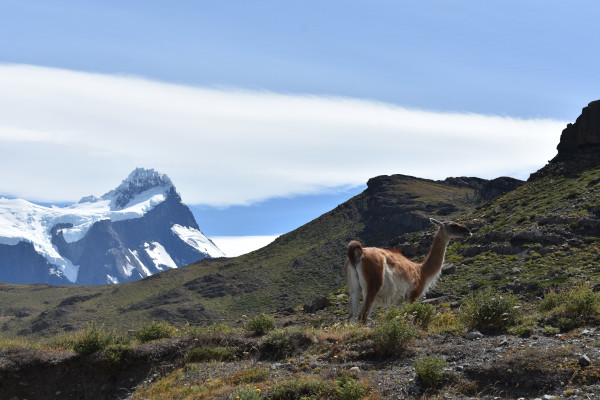Patagonia is a wild and beautiful place filled with some of the most wonderful sights on earth. This wilderness is made accessible by cozy towns, decent roads and warm hearted locals. Backpacking in Patagonia is a rewarding experience for seasoned travelers as well as those setting off on their first trip.
I have been fortunate to fulfill a lifelong dream of visiting Patagonia. I explored from North to South, across both Chile and Argentina. All with a huge backpack and tiny budget!
In this article is everything you need to plan and prepare for your backpacking adventure.
Backpacking In Patagonia- Planning Your Trip
When Should I Backpack In Patagonia?
When to plan your backpacking trip in Patagonia depends on your interests. Most people are looking for the best time to go hiking in Patagonia. However, you may want to avoid the crowds or experience the landscape transformed by snow. This is a general overview of what you can expect, season to season.
Summer (December to February)
Summer is the peak season for hiking in Patagonia. Temperatures are warm, from 10°C to 20°C (50°F to 68°F), and you will have longer daylight hours to hike. At this time of year, skies are reliably clear which means you get great views of the most beautiful mountain landscapes.
The big downside to backpacking Patagonia in summer is that some regions are crowded. I found El Chalten and trails in Torres del Paine National Park especially busy over the summer.
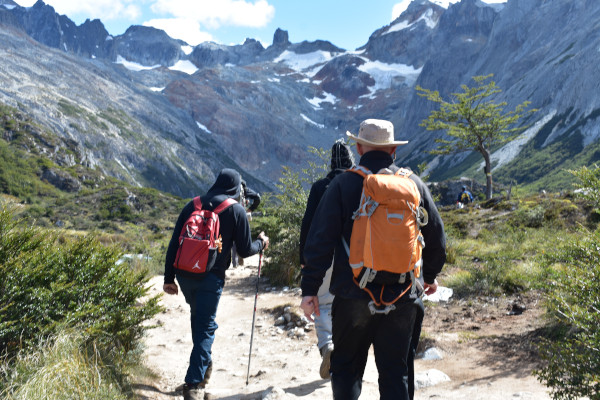
Busy Trails over the summer months in Patagonia
Prices for accommodation and tours tend to be higher during this season. You will need to reserve accommodation about 6 months in advance for the W Trek Or O Trek.
Fall (March to May)
Fall is considered a shoulder season in Patagonia. Cooler temperatures range from 3°C to 14°C (37°F to 57°F). The crowds thin out during this season, making it a great time if you like having the trails to yourself.
The orange, red, and yellow leaves make this one of my favorite seasons to hike Take note, fall days are shorter and the weather can be unpredictable. You may experience rain, snow, and strong winds. Be prepared, even if the day looks clear, to begin with.
Winter (June to August)
Winter is not the best time for hiking in Patagonia as temperatures can drop below freezing. Many trails are closed due to snow and ice or are only accessible with a guide.
Blanketed in snow, Patagonia is transformed into a different world over these months. Winter is an excellent time for alternative activities like skiing and snowboarding in Patagonia's ski resorts. You can also take dogsledding tours near Ushuaia.
Spring (September to November)
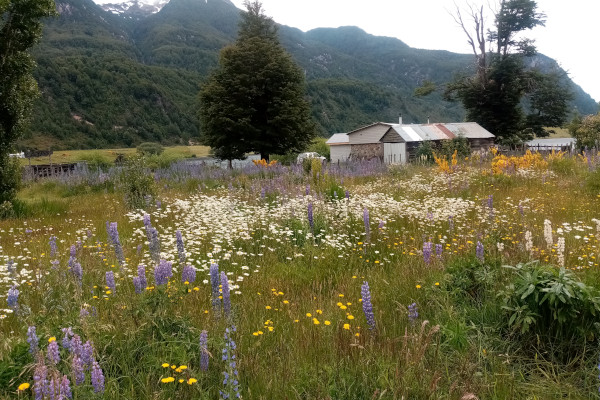
Spring Flowers On The Caraterra Austral
Spring is another shoulder season. Days are still long with temperatures ranging from 6°C to 16°C (43°F to 61°F).
The crowds have yet to arrive, making it an ideal time to explore the trails. However, the weather can be unpredictable, and you may experience rain and strong winds.
How Do You Get To Patagonia - Flights Vs Buses
You could bus to your Patagonian destination but I found that internal flights were affordable and a better option for crossing the country. It's better to have more time for exploring Patagonia itself.
Contrary to popular belief, buses are not always cheaper than flights.
For instance; If you tried to bus all the way from Buenos Aires to El Chalten, you would need to make two connections. The journey would take you around 45 hrs and cost you around $220.
Flights to El Calafate cost between $120-$240 (depending on the season). From here it is a quick 3hr/ $35 to El Chalten.
I don’t need to tell you which option I chose!
Check flight deals before booking that long-haul bus rides! Aerolineas Argentinas, Sky Airlines And LATAM.
That said if you have ample time and are dead set on seeing the entire landscape. You may choose buses.
At Which Airport Do You Land In Patagonia?
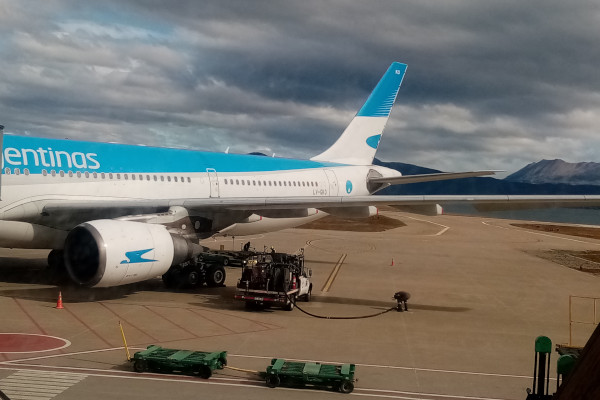
Aerolineas Argentinas at Ushuaia Airport
Here is a quick key to which airport to fly into, depending on where you are visiting.
El Tepual International Airport (Puerto Montt, Chile)
The ideal starting point if you are exploring the Carretera Austral from the top. There are many car hire options from here. Buses also depart regularly to Chaiten.
Balmaceda Airport (Coyhaique, Chile)
If you don’t have time to travel the entire Carretera Austral, Coyhaique is a good point from which to explore the Aysen region.
Teniente Julio Gallardo Airport (Puerto Natales Chile)
A good central point from which to reach some of Patagonia's major trekking destinations. Torres Del Paine National Park is a two-hour drive away. From here, you can also bus to El Chalten via El Calafate.
Presidente Carlos Ibáñez International Airport (Punta Arenas, Chile)
From here you can bus/ hitchhike to Puerto Natales, the gateway to Torres Del Paine. You could also continue south and cross the ferry to Isla Tierra De Fuego. Once on Ta Del Fuego, it is a simple border crossing and a relatively easy trip to Ushuaia.
San Carlos De Bariloche (Bariloche, Argentina)
This airport services the town of Bariloche in the Northern part of Argentina’s Patagonia. Known as the 'Switzerland of Argentina', Bariloche is famous for its ski slopes and chocolate shops.
Comandante Armando Tola International Airport (El Calafate, Argentina)
El Calafate is famous for the Perito Moreno Glacier. It is also a good town to stock up on supplies before heading to El Chalten to hike Fitz Roy.
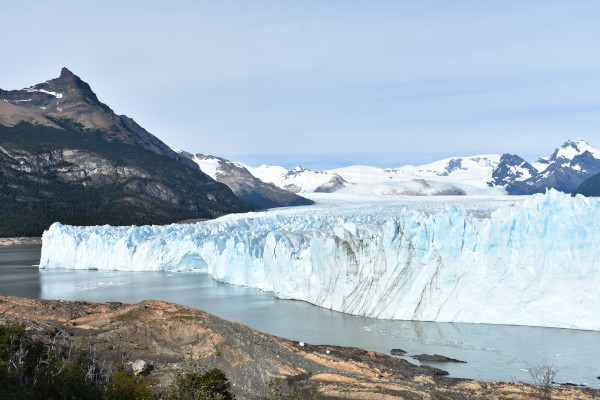
The Perito Moreno Glacier is a 2 hour drive from El Calafate
Malvinas Argentinas International Airport (Ushuaia, Argentina)
The southernmost tip of the continent and harbor for cruise ships to Antarctica.
Top Money-Saving Tips For Booking Flights In Patagonia
Here are some hacks I’ve learned through booking multiple flights in Latin America. I wish I’d known some of these sooner.
Don’t Fly Between Chile and Argentina
Book national. Argentina and Chile’s internal flights are much cheaper than flying between the countries. Stick to flying from Argentina airport to Argentina airport and the same for Chile. If you need to cross the border, its cheaper to do it by land.
Book Directly Through The Airline
Booking Flights on the airline website is almost always cheaper than through third-party sites. Instead of booking the ticket with luggage included, select the most basic package. When the option comes up, add on the luggage you need. This has saved me hundreds of dollars over the years!
Most Latin American airlines are also cheaper when you book through the Spanish site. If you don’t switch to English, Airlines give you a much cheaper ticket price. It’s worth comparing.
Be Prepared For Delays And Cancellations
South American Airlines are notorious for unreliable flight schedules. When making your plans it’s worth giving yourself an extra day to allow for flight delays. Having some flexibility could save you a lot of stress and inconvenience.
Getting Around Patagonia
Once in Patagonia, you have a few options for traveling shorter distances.
Rent A Car- Higher budget
If you have the cash, renting a car will give you the most freedom to explore Patagonia. There are a lot of hiking trails and attractions that cannot be reached by public transport.
If you split the cost between friends, car rentals can be reasonably affordable. If you are traveling solo or looking for more people to share costs with, Facebook pages are a good place to find like-minded travelers.
Car rentals cost about $350-$450 per week. If you are planning on hiring a car, make sure you know all the regulations for crossing borders as well as where you can return the vehicle.
Buses In Patagonia- Affordable For Popular Routes
Buses in Patagonia are not cheap. Having come from Peru and Bolivia, where public transport costs next to nothing, It was a shock arriving In Chile.
Even so, in Patagonia’s main towns, you can find buses running to major parks and attractions. Tickets for tourist routes usually cost between $10-$20.
Note: There are not many bus options on the Chilean side of Patagonia. Even buses between towns in Chile Patagonia do not run every day. Make sure you check the schedule well before you plan on moving on.
Hitchhiking Patagonia- Your Cheapest Option
If you are patient, speak some Spanish, and need to save every last penny, hitchhiking to Patagonia is the way to go!
Coming from a country where hitchhiking is frowned upon, I was a little hesitant to try hitchhiking. However, several locals and other travelers insisted I give it a shot. Man, am I glad I did!
Other than the obvious fact that I save a stack of cash, hitchhiking to Patagonia had some real benefits. You will meet interesting people (tourists and locals) as well as get a chance to practice your Spanish.
Once you start chatting with the driver, it's not uncommon to be o invited for a meal or even offered accommodation for the night. Don’t worry, Patagonia is very safe for hitchhikers. Particularly the Chilean region on the Carretera Austral. I would be a little warier of hitchhiking in the Northern parts of Patagonia, Argentina.
Ferries In Patagonia
Traveling through Patagonia is by no means a direct route. You will sometimes need to cross a fjord or lake by boat in order to reach your next destination. Most of these crossings take less than an hour but there are a few longer trips.
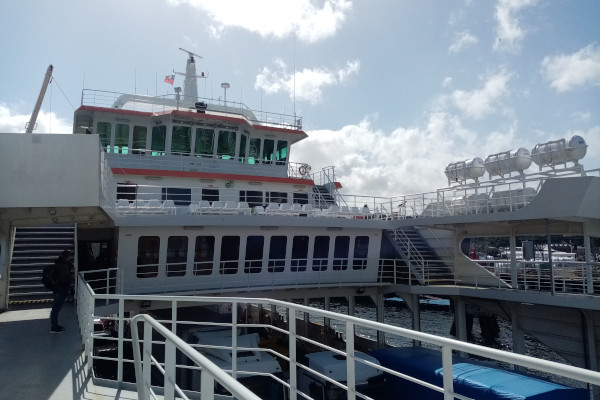
A Ferry crossing in Chile
Bus tickets that make such a crossing include the ferry in their price. If you are traveling independently, you will need to pay the ferry price (generally around $10). You usually pay at the office on the ferry itself.
Where To Stay In Patagonia-Backpacker Friendly Options
Compared to other South American countries, accommodation in Chile and Argentina is expensive. Even so, you can still find some good options. Most of Patagonia’s cheapest and best stays are not listed on sites like HostelWorld or Booking.com. If you want the best deals, be prepared to hunt around.
How To Find Cheap Accommodation In Patagonia
My top tip is to use the accommodation filter on Google maps. The places that come up with prices and links to a booking site are generally the expensive ones. Instead, look for places with a few decent reviews and a phone number.
Most accommodation owners use WhatsApp. Just remember to type in Spanish, you may need to enlist the help of Google Translate.
Dealing directly will usually get you the best price. This method works particularly well in finding hospedajes in Chile.
Camping- $0-$25
Campsites are the cheapest option for accommodation in Patagonia. This only applies if you have your own tent and camping gear. Renting equipment day by day will add up quickly.
If you are traveling in the peak season (December- March) you may find you have limited accommodation options. Luckily, you will almost always find a place to pitch your tent, even if you arrive last minute!
Most organized campsites cost between $10 (a general camp in town) to $25 (a pre-booked site in Torres Del Paine). There are also many free campsites to be found along multi-day hiking routes. Google Maps shows most of these sites. Try searching ‘free campsite’.
Note: Free Campsites in Torres Del Paine are closed for the 2022/2023 season. When they do re-open, they need to be reserved several months in advance.
Hostels- $15-$25
In Argentina, you will find backpacker hostels in most tourist towns. Just like anywhere else in the world, these hostels offer cheap dorm rooms (from $15) as well as private rooms (from $20pp). Most Argentinian hostel rates include a simple breakfast.
You will find very few classic hostels in Chilean Patagonia. Instead, look out for hospedajes that are in a similar price range.
Hospedajes, Pensiones and Residenciales- $18-$30
These are types of local B&Bs. You may have the option to include meals and many of these places have WIFI. These types of accommodations offer affordable private rooms with access to a shared bathroom and kitchen. Expect to receive a warm welcome and soon feel at home.
How Much Does Backpacking Patagonia Cost?
How much to budget for Backpacking in Patagonia is going to vary widely. It depends mainly on the length of your trip and your travel style.
Contrary to popular belief, a longer trip can actually work out cheaper. A flexible schedule means you can afford to wait for flight deals and rides between towns. By staying in one place longer, you can often get better accommodation offers.
Below is a very rough estimate of the costs you might expect while backpacking in Patagonia:
- Accommodation: Dormitories/ rooms from $10-$30 per night, while campsites can be as low as $5-$10 per night.
- Food and drink: A budget of $15-$25 per day should cover basic meals at local restaurants. It’s going to cost you a lot less to buy and cook your own food. If you are smart about it, you can spend as little as $10pp a day.
- Transportation: The most common way to travel around Patagonia is by bus. You can expect to pay around $15-$30 per journey.
- Tours: Excursions Patagonia are relatively expensive at $50-$100 per day for guided tours or equipment rentals. Do as much as possible without a tour. Check out this article on hiking Patagonia without a guide.
- Miscellaneous expenses: Don’t forget you should buy travel insurance. Also budget for additional expenses like souvenirs or entrance fees to national parks. Budget around $10-$20 per day for these expenses.
Based on the above estimates, a rough daily budget for backpacking in Patagonia would be around $50-$100 per day. This would be a relatively cushy experience where you take tours every day and eat/ drink out fairly often.
Realistically, you can get away with spending $25-$30 each day. This is if you are prepared to hitch-hike wherever possible, camp, and cook your own simple meals.
Patagonia by Region
You may be having a hard time deciding what part of Patagonia to visit.
This section covers the main regions of Patagonia. Unless you have extended travel plans, I recommend sticking to one or two regions. This way you can thoroughly explore and get the most out of your trip.
Patagonia Chile Backpacking - Carretera Austral
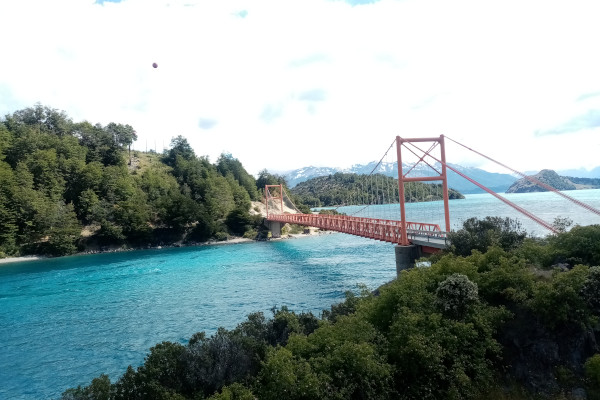
A typical view along the Caraterra Austral
There is only one main road through Chile Patagonia, the Carretera Austral. This road is tarred in some parts but is mostly a narrow gravel track flanked by some of the wildest places you could imagine. In short, it is a backpacker's dream!
This famous route runs 1240 km from Puerto Montt to Villa O'Higgins. One of the best things about this road is that it is easy to hitchhike along. This makes it simple to get to trails or attractions from the towns. Some of the towns also have taxis, you can ask at your accommodation for a driver’s number.
Below are some of the highlights along the Carretera Austral:
Pumalin Park - Chaiten
Around 200km south of Puerto Montt, Pumalin Park. It was set up by Doug Tompkins, co-founder of The North Face. The park was later gifted to the Chilean State. There is an extensive network of trails that are all freely accessible to the public.
Some of the best trails in Pumalin include out-and-back trails to Cascadas Esconidas, Chaiten Volcano and Laguna Tronador. These are short hikes and you could do most of them in a single day. Don’t miss Sendero Los Alerces which is a short stroll to see one of the last remaining forests of ancient Alerce trees
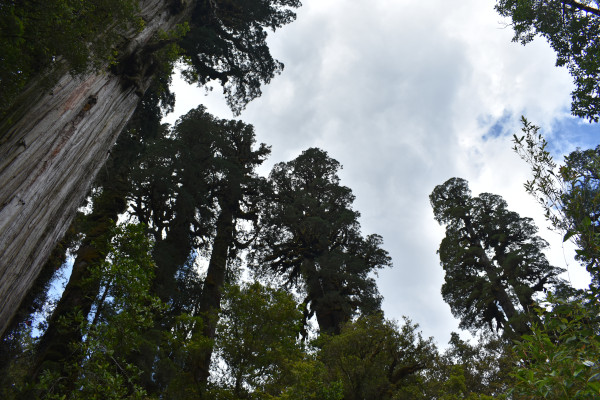
Gigantic and ancient Alerce trees in Pumalin National Park
Puyuhuapi
Puyuhuapi is one of my favorite towns in Patagonia. It is absolutely tiny and situated at the edge of a fjord. For a change from hiking, rent a kayak and get out on the water. Look out for pods of small dolphins and the occasional sea lion.
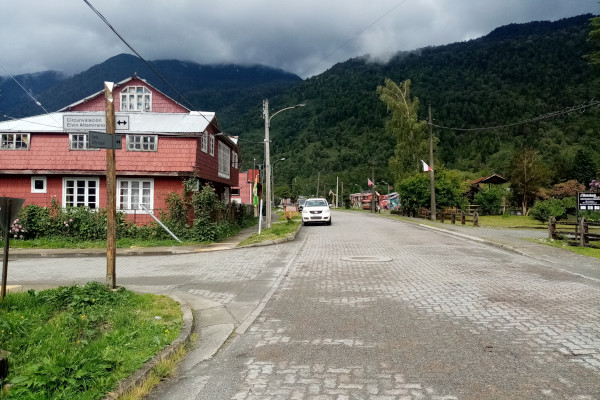
Puyuhuapi
Most people visit Puyuhuapi in order to get to Parque Quaulet to see the Hanging Glacier. The glacier viewpoint is only one hour hike from the Park entrance. The entrance fee is 9000CLP/ $10
Cerro Castillo National Park
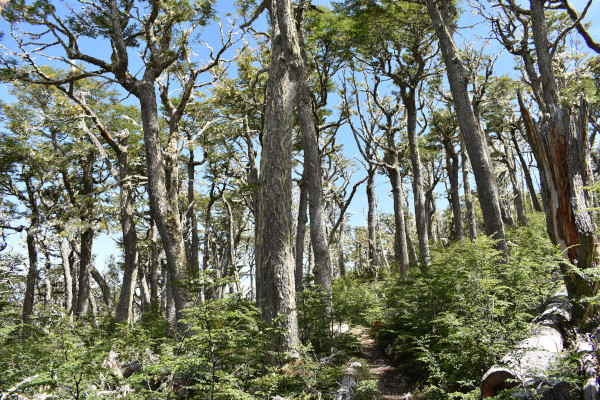
Lenga Forest
330km South of Coyhaique, Cerro Castillo has one of the best multi-day hikes for adventurous backpackers. It’s best to start at Laguna Chiguay where there is a CONAF ranger station and trail information. The loop is 62km and is mainly through native forests of Lenga trees.
It takes most people 3-4 days camping at very basic sites.
Puerto Rio Tranquilo
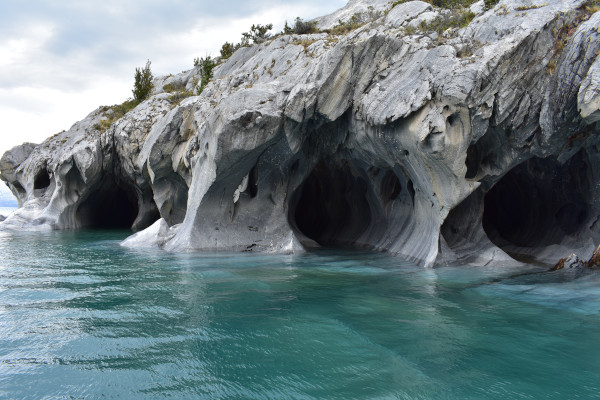
Cuevas de Marmol, Rio Tranquilo
On its own, Puerto Rio Tranquilo is an unremarkable town. The attraction here is the Cuevas de Marmol or Marble caves. These spectacular natural features can only be accessed by a boat or kayak tour. Several companies offer boat tours from 20000CLP ($25) twice a day.
From Rio Tranquilo, you can also book a trekking excursion to the Exploradores Glacier. This is one of the best day hikes in Patagonia.
Patagonia National Park
This is a huge park that stretches over the Chilean and Argentina sides. From the Chile side, the entrance to the park is just outside Cochrane. It would be difficult to hitchhike here as the hiking trails begin about 9km from the entrance gate on the main road.
Tamango National reserve, on the outskirts of Cochrane, is easier to get to and has several beautiful day hikes. You may also spot Huemul deer in this reserve.
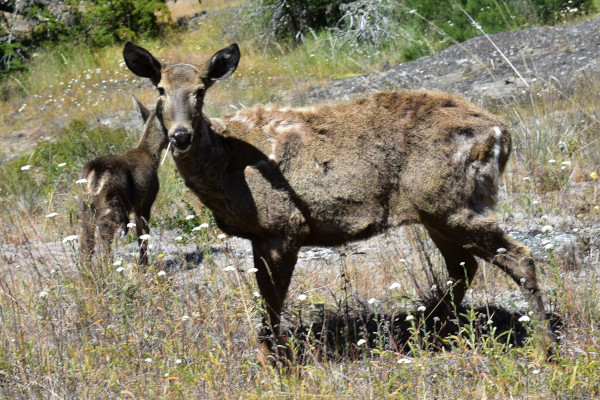
I was lucky enough to see this mother and fawn in Tomango Reserve, Cochrane
Villa O’ Higgens
If you get here, you would have made it to the end of the Carretera Austral. O’Higgins looks like a scene from a Christmas postcard. I spent a week here at one of my favorite hospedaje (look for hospedaje Fabiana on the corner of the plaza).
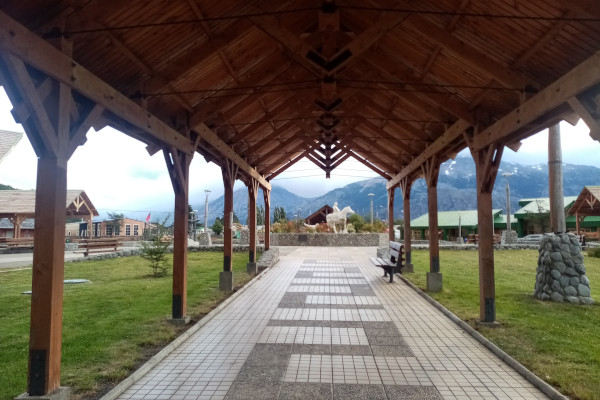
Villa O'Higgins
There are some amazing hiking trails around these parts. You can also cross the border to El Chalten from O’Higgins. This is probably the most expensive and adventurous border crossing in Patagonia. The crossing involves two ferries and some trekking.
Patagonia Chile Backpacking - Torres Del Paine
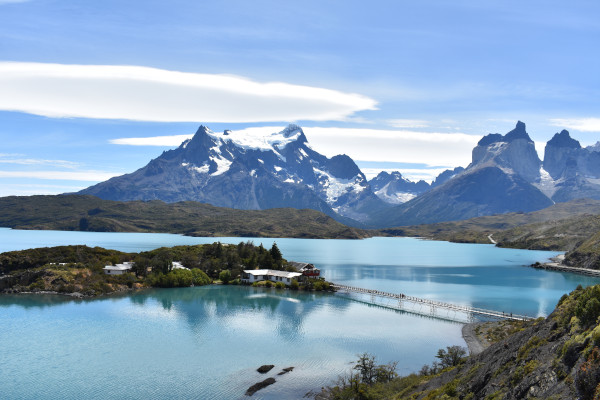
Torres Del Paine, Patagonia's most famous park
This well-known park is located about 60km/ 35 miles from Puerto Natales. Torres Del Paine has features that represent the best of what Patagonia has to offer. Impressive granite mountains, sparkling lakes, glaciers, and waterfalls. The 700 square miles of protected land also house a variety of wildlife and plant species.
Hikes in Torres Del Paine are some of the most famous in Patagonia. If you plan to do a multi-day trek, be sure to book your campsite well in advance.
Backpacking Patagonia Argentina
Bariloche
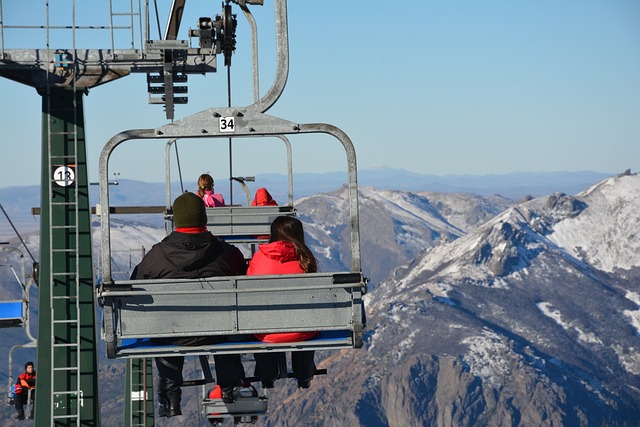
Ski lift in the mountains near Bariloche
Bariloche is in the most northern part of Patagonia Argentina. The architecture here has a strong German influence. Bariloche is known for its chocolate shops, good restaurants, and craft beer. Many people consider this the most charming town in Argentina.
One of the main attractions near Bariloche is Nahuel Huapi National Park. The park covers an extensive area with a huge network of hiking trails. You can also go mountain biking, horse riding, fishing, or white water rafting.
Bariloche has some of the best ski slopes in Argentina. If that’s your thing, put this town on your list of winter destinations
El Chalten
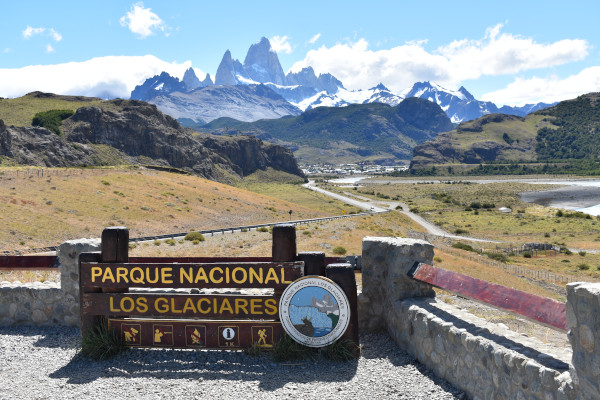
Entrance sign to Los Glaciares National Park, El Chalten
The capital of trekking in Patagonia. It would take you more than a week to fully explore the trails around El Chalten. One of the best things about this area is that access to the trails (and corresponding campsites) is free.
This doesn’t mean El Chalten is cheap. Expect to pay around 50-100% more for groceries than anywhere else in Patagonia. El Chalten also gets extremely busy over the Summer season. Be prepared for crowds.
Perito Moreno Glacier, El Calafate
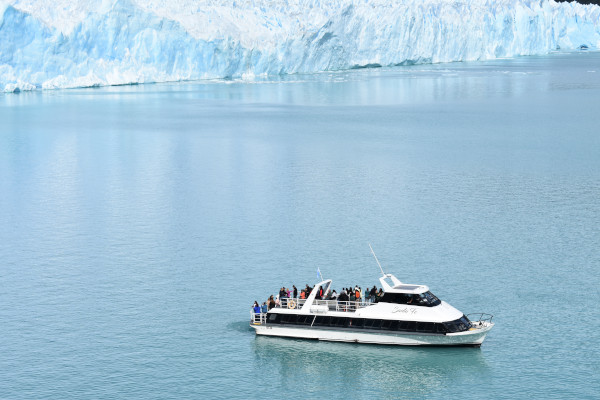
You can get closer to the Perito Moreno Glacier by boat, I felt close enough from the viewing platforms
El Calafate, Argentina, is conveniently located between Torres Del Paine, Chile, and El Chalten. It makes for a convenient stopover if you are traveling in either direction between these towns. Besides this, the number one reason you should stop here is to visit the Perito Moreno Glacier.
This is one of the most impressive and accessible Glaciers in the world. The giant chunk of ice has a life of its own. It’s easy to spend hours listening to it groan and watching chunks split off and thunder into the water below.
The entrance fee (as of 2023) is 5,500ARS/ $30. The price is definitely worth it!
Ushuaia, Tierra Del Fuego
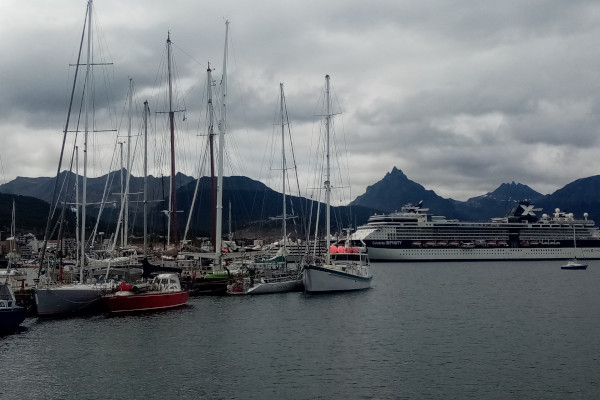
Ushuaia harbour is a scenic place to take a stroll
Fondly known as the end of the world, Ushuaia is often the final stop for travelers in Patagonia. Seemingly endless hikes to discover, penguin tours, and great restaurants are some of the reasons that this is one of my favorite stops in Patagonia.
Money Matters- How to Pay For Things In Patagonia
What Is The Blue Dollar, Argentina?
The blue dollar rate is the unofficial but widely accepted exchange rate in Argentina. Basically, you can exchange your cash for almost twice the official exchange rate.
Even though this is not a strictly legal or regulated system, the Blue dollar and Tourist Dollar rates are very much normalized. Many travelers send money to themselves through Western Union. This way you can benefit from the best rate without carrying stacks of bills around.
You can also send cash from Chile to Argentina through Chile Express (which is partnered with Western Union), at the same amazing exchange rate.
You will have to physically draw Chilean pesos to take to the Chile express counter. Even with high withdrawal fees in Chile, you still benefit from the currency exchange difference. Note that you cannot send cash to yourself but you can send it to whoever you are traveling with and vice versa.
If you do have dollars with you, there are several places to exchange cash in each town. Souvenir shops are a good place to ask. The rate is not as high as Western Union, but it’s still a good deal! You will get more for larger, crisp bills than small or worn ones.
The good news is that Mastercard and Visa have jumped on this bandwagon. As of January 2023, foreigners receive a refund of the difference between the tourist rate and the official rate (around 40% of purchase). Visa cardholders should see this reflected almost immediately in their account. Mastercard takes up to a week to process.
With the crazy inflation rate in Argentina, no one knows how long this unofficial rate will last. Best to take advantage while you can!
Is It Better To Use Cash Or Pay By Card In Patagonia?
When it comes to paying with cash or with a card in Patagonia, it’s best to have both. I found almost all accommodation types only accepted cash.
You can pay at restaurants, supermarkets, and even most park entry fees with debit or credit card. I always carry cash just in case!
Is It Easy To Find An ATM in Patagonia?
Most Patagonian towns have several ATMs. O’ Higgins is one notable exception as there is nowhere to draw cash here.
Having said this, ATMs do not always have sufficient cash to withdraw the amount you want. It’s better to get money when you are in bigger towns like El Calafate in Argentina or Coyhaique.
You should also know that cash withdrawal fees in Chile and Argentina can be ridiculously high with a foreign card. Fees run between $6-$8 and daily withdrawal limits are capped.
Backpacking Patagonia - Frequently Asked Questions
Is Patagonia Safe For Solo Female Travelers?
Patagonia, particularly the Chilean side, is very safe. So much so that homeowners leave their doors unlocked! This makes it one of the best destinations for solo female adventurers. I spent months backpacking through both sides of Patagonia on my own and never felt unsafe.
Which Sim Card Should I Buy For Patagonia?
While in Argentina, the best cellular network is Claro. A prepaid sim card usually includes free WhatsApp for the month as well as some data.
When I bought my Claro chip, the assistant assured me that this card would also work in Chile, Bolivia, and Peru. I didn’t get to test this as I was already coming from those countries. Claro sim cards from Chile DO NOT work in Argentina.
The only network that covers Chile Patagonia is Entel. Even then, reception can be sketchy!
Do You Need Travel Insurance For Backpacking Patagonia?
The short answer is yes. Just like any trip, things can and do go wrong. It’s better to be prepared. At the least, you should buy travel insurance that covers basic medical treatments and hospitalization. I recommend taking out cover that includes cover for baggage loss and theft of belongings.

